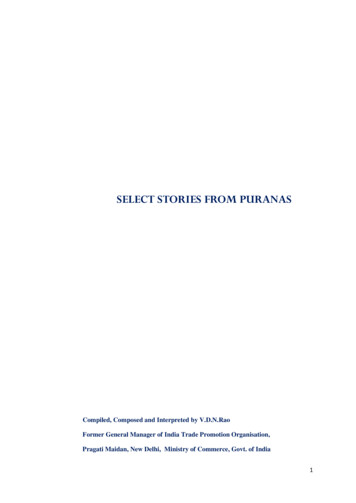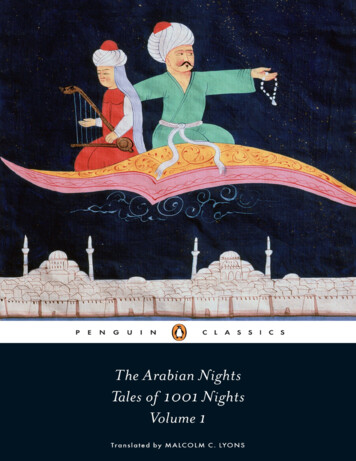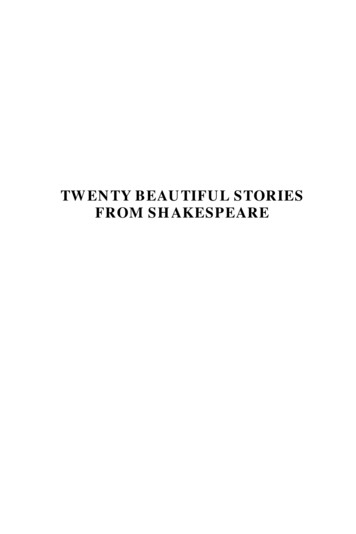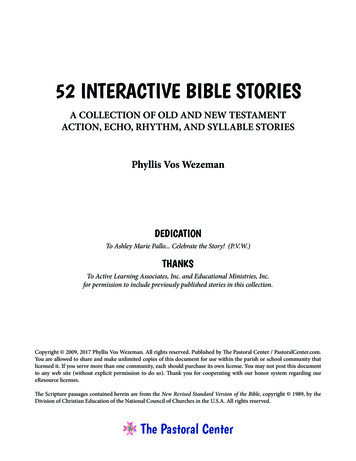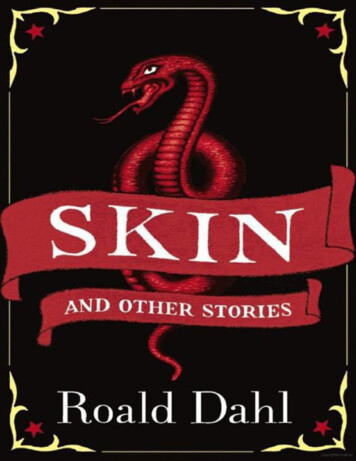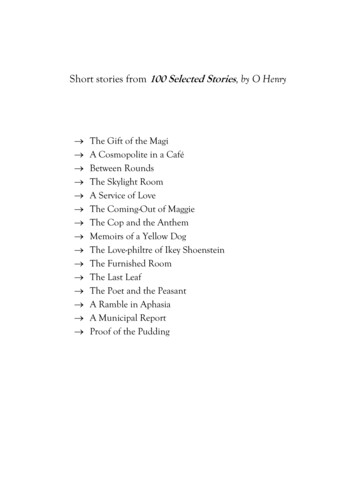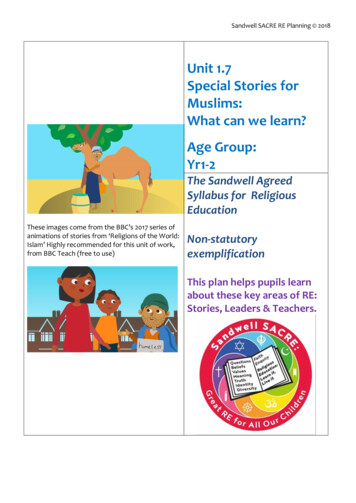
Transcription
Sandwell SACRE RE Planning 2018Unit 1.7Special Stories forMuslims:What can we learn?Age Group:Yr1-2The Sandwell AgreedSyllabus for ReligiousEducationThese images come from the BBC’s 2017 series ofanimations of stories from ‘Religions of the World:Islam’ Highly recommended for this unit of work,from BBC Teach (free to use)Non-statutoryexemplificationThis plan helps pupils learnabout these key areas of RE:Stories, Leaders & Teachers.
Sandwell SACRE RE Planning 2018Special Stories for Muslims: What can we learn?Age Group: Yr 1-2ABOUT THIS UNIT:Islam is a major religion in Sandwell, the UK and globally. It is a requirement of the Sandwell RE syllabus thatpupils learn about Islam throughout their primary school years, as well as about Christianity and otherreligions. This unit is founded on story telling, which is an important part of Islam: stories of the life of theProphet Muhammad [PBUH] form part of the ways children are nurtured in Islamic faith, and also a part ofRE, where children can enjoy the stories and learn from them about Islamic ideas. The Hadith of the Prophetare collections of stories and saying about his life and are important in Muslim life, though the Qur’an itself isunderstood to be unique: a final revelation of Allah.Estimated time for this unit: 6 hours. It might take longer to do all these activities: teachers should aim fordepth rather than hurrying across too much content.Where this unit fits in:Through this unit of work many children who are not Muslims will do some of their first learning about theIslamic faith. They should learn that it is a local religion in Sandwell and matters to people they live near tothemselves. Other children who are Muslims may find learning from their own religion is affirming of theiridentity, and opens up channels between home and school that help them to learn. This is the first unit onIslam in the syllabus and it makes an important starting point for further learning throughout the primaryschool.KEY STRANDS ADDRESSED BY THIS UNIT Beliefs and practices Questions of belonging and identity.ATTITUDES FOCUS: Respect for all: noticing and being ready to value difference and diversity for the common good Self-awareness: feeling confident about their own beliefs and identity and sharing them without fearof embarrassment or ridicule. Curiosity and enquiry: being willing to ask questions and take a wide interest in the world aroundthem.Background information for the teacher about Islam: simple starting pointsThe unit picks up some key areas for learning from Islam, and connects them to the children’s own ideas andexperiences. Teaching stories of the Prophet connects to other dimensions of Muslim belief and practice.The word Islam means submission or peace. Muhammad was born in the city of Makkah in 570 CE (CommonEra, the same as BC/AD dating). Muhammad is not seen as the founder of Islam but rather as the finalProphet, the first of whom was Adam. There are many other prophets mentioned in the Qur’an and theirstories are partly shared with Judaism and Christianity – famous examples include Ibrahim (Abraham), Musa(Moses) and Isa (Jesus). Prophet Muhammad is known to Muslims as the ‘Seal of the Prophets’, the lastprophet.Muhammad was a trader happily married to his wife, Khadija, a devout worshipper. At the age of 40 he beganexperiencing a series of revelations from God. These revelations were delivered by the Angel Jibril (orGabriel) over a number of years and came to form the sacred text of the Qur’an. The Quranic text was writtendown, during the life of the Prophet, although it was compiled as one volume only after his death. The wordsare regarded as a direct transmission of revelation from God Himself. Allah is the Arabic word for God.The Qur’an was revealed to the Prophet Muhammad over a 23-year period. Muslims show their love andobedience to God by being obedient to the words in the Qur’an and living as closely as possible to the waythe Prophet lived. The Qur’an gives guidance on a range of topics about everyday life, ethical, spiritual, socialand moral issues. It is treated with reverence, being handled carefully, and ideally read on a daily basis.Children will often learn to read Arabic and recite the Qur’an at an early age. Recitation is important toMuslims: the words of the Quran have a power when spoken that doesn’t go with them being read silently.
Sandwell SACRE RE Planning 2018The Shahadah (The declaration of faith)‘There is no god but the One God and Muhammad is the Messenger of God.’Belief in the oneness of God is the foundation of Islam. The words of the Shahadah form part of the words ofthe Adhan, which are the first words whispered into the ear of a newborn baby and are also the last words aMuslim will hope to hear before s/he dies.Salah (Prayer)The ritual prayers (salah – also referred to as namaz), are offered five times a day. All Muslims are required topray from the age of about 12. Prayer enables one to develop a closer relationship with God. Prayers are saidat specific times of day, (once early in the morning, once in the night and the others dispersed through theday), the times will alter slightly depending on the time of year. At the mosque, Muslims pray in rows behindthe Imam, the leader of congregational prayers. Prayer can be carried out anywhere that is clean. Often aprayer mat is used to pray on, but as long as a space is clean it is not essential to use one. Muslims will have tohave made Wudu (ritual washing), before they pray, so access to water is useful. Muslims face Makkah(towards South East in the UK) when they pray.Id-ul-Fitr celebrates the end of the fast of Ramadan. This is a time to ask for forgiveness, thank God foreverything He has blessed one with and share in congregational prayers. Special food is prepared and sharedwith family and friends. Presents are given and new clothes are often bought. This is also a time whenMuslims will visit the cemetery and remember dead family and friends.
Sandwell SACRE RE Planning 2018Prior learningVocabularyResourcesIt is helpful ifpupils have: Someknowledge oftheir localarea (ifvisiting anearbymosque) Backgroundknowledge ofIslam Know how totake aphotographIn this unit, pupilswill have anopportunity touse words andphrases relatedto:ResourcesRE Today Services (www.retoday.org.uk) publish relevant items: Opening up Islam: Ed. Fiona Moss Say Hello To. and ‘Share a story with ’ RE Today – 2 x 6 flash books forthe whiteboard introducing a child from different religions to the classsimply and telling faith stories. A good start in Year 1 RE Talking Pictures: A picture pack by Fiona Moss and Stephen Pett from REToday, 2012, with a disc and site license. Lots of good visual learning ideasfor younger pupils on Islam, Judaism and ChristianityWebUse local pictures: www.muslimsinbritain.org lists 29 mosques in Sandwell.www.ngflcymru.org.uk/vtc/ngfl/re/m parry carmarthenshire/e index mosque young for avirtual Mosque tourwww.islam4schools.com/infant for a recording of the call to prayer (Adhan)www.eastlondonmosque.co.uk The website of the East London mosque – has agood visual section.Recording of the call to prayerhttp://www.reonline.org.uk/allre/tt nframe.php The BBC’s clip bank is a major source for short RE films that can beaccessed online and shown free: http://www.bbc.co.uk/learningzone/clips The BBC also offers lots of information and material on its main religionsite: www.bbc.co.uk/religion A programme about s/eid ul fitr.shtml The best gateway for RE sites is: www.reonline.org.uk/ks1 You can find and use searchable sacred texts from many religions at:www.ishwar.com There is some more TV material at: www.channel4.com/learning The websites of REToday and NATRE are useful places for pupils andteachers to see examples of work. www.retoday.org.uk andwww.natre.org.uk/spiritedartsTexts - teachers might use: Qur’an (use and explain a cloth cover and stand) The Qur’an and Islam, Sacred Texts by Anita Ganeri, Evans Brothers Ltd The Tiny Ants – a big book version of one of our stories. Good RE activitiesfrom www.booksatpress.co.uk by Gill Vaisey Channel 4 broadcasts and videos e.g. Water, Moon, Candle & Sword(video, teachers’ guide and activity book available) There is a very good selection of authentic materials about Islam forchildren available from the Islamic Foundation in Leicestershire:www.islamic-foundation.com . Story books, audio and video tapes andposters are all useful.Artefacts and books A range of religious artefacts can be purchased with notes and teachingideas from Articles of Faith (Bury) www.articlesoffaith.co.uk/ or Religion inEvidence www.tts-group.co.uk (Chesterfield) Qur’an and stand or poster; prayer mat; new clothes wrapped as a gift;Charity box, Id cards My Id-ul-Fitr, Little Nippers, Heinemann The Swirling Hijaab Sacred Texts: The Qur’an and Islam My Muslim Year by C Senker, Hodder Children’s Books My Life My Religion: Muslim Imam by Masood Akhtar Where we Worship: Muslim Mosque A present for Salima by K Marchant, Hodder Children’s Books ‘Tapestry of Tales’ Sandra Palmer and Elizabeth Breully (Published byCollins). ‘101 Ideas for spiritual and Moral Development in RE’ (Ed. Rosemary Rivett,RE today 2013)IslammosquewuduQur’anReligion ingeneral:specialHolysacredprayerworship
Sandwell SACRE RE Planning 2018EXPECTATIONSAt the end of this unit:Most pupils will beable to work at step1: Many pupils will beable to work at step2:Some pupils mightbe able to work atstep 3, and will also: Talk about the Prophet and why he matters to MuslimsIdentify a Muslim holy book or special dayChoose a special word for themselvesTalk about what matters to themIdentify the holy book of Muslims as the Qur’anThey will be able to talk about why a book is special to them.They will be able to say something about Muslims’ beliefs and somethingabout their own beliefs about God.They will be able to remember some stories they have enjoyed.Retell two stories of the Prophet MuhammadTalk thoughtfully about kindness to animals or about sacred wordsRespond sensitively to Muslim ideas and simple stories, suggesting ameaning in a story for themselves.Remember the Muslim belief that the Qur’an was revealed to ProphetMuhammadRespond sensitively to simple questions about the stories they have heardRetell three or more stories of the Prophet in detail and identify messagesthe story holds for MuslimsDescribe how Muslims use and respect their holy booksMake links between the stories and their own livesASSESSMENT SUGGESTIONS Listen to children talking about the learning activities, and note the language used, what they haveremembered and how they respond – sensitive responses are important.Ask questions about what things in Islam mean – suggesting meanings is an important skill in RE for5-7 year oldsSee how the children respond in talk and listen activities to the different things they learn aboutmosque, prophet, Qur’an and Eid.A table of artefacts and photos and books is a good way to focus this conversation, and capturewhat children say about Islam so that you know how their learning has progressed.You could use a card – sorting task. Using key words (pictures are to be avoided as Muslims refuseto make pictures of the Prophet, for example), children choose three from 8 objects or words andsay why these matter in Islam. E.g. Prophet / Qur’an / Eid / Stories / Animals / Messages / Angels /Mosque / Qur’an stand / prayer mat.Listen to the pupils’ reasons for selecting their chosen words.Can they choose three words that matter very much to them? Friends? Peace? God? Laughing?Food? Love? Caring? Animals? Other words?The unit will provide these opportunities: Pupils have opportunities to think about and talk about stories from the Muslim religion, beginning tolearn discussion and listening skills. Pupils have opportunities to consider a diverse range of views about questions of value: what matters,and who to?
RE Support 2017Why are some books special? How can you show respect for a book? How do Muslims respect their holy writings? That books arespecial fordifferentreasons fordifferent groupsof peopleMuslims believethe Holy Qur’anis the word ofGod / Allah andis thereforetreated withutmost respect.There aresymbols forrespect: somethings we dowith a bookshow how muchthe book isloved and caredfor.To notice and torank 7 signs ofrespect Muslimsshow to theQur’an.Our special books: display and talk Have a display of books. This will include special books that pupils have brought in, somefavourites from the classroom, or chosen, some versions of the Bible and a Qur’an which is on itsstand and covered – higher than other books. Take a photograph of the display and enlarge fordisplay purposes, e.g. to use on the whiteboard. Ask pupils to look at the books and select two books they would like to ask questions about. Inpairs, ask them to come up with 5 questions about each of the books they chose. Thesequestions can be put on card and attached to the photo of the display. Some questions can should be dealt with quickly, but more time and focus needs to be given toquestions about the Bible and the Qur’an: such questions as ‘Why is this book special?’ ‘Whowrote this book?’ and ‘What is this book about?’ ‘Why is this book on a stand?’ ‘Why does thisbook have gold letters on the front?’ ‘What does ‘Holy’ mean?’ Tell the children that in this part of RE, they will be finding lots of questions, and answers aboutsacred books – and that ‘sacred’ is a religious kind of ‘special.’ Tell them that holy books oftenhave great stories in them – they are not just story books, but lots more as well. For 5-7 year olds,one of the best ways to find out about what makes a book holy is to think about some of thestories it tells. Teach the class that the Muslim religion’s sacred book, the Qur’an has some storiesin it, but Muslims also like to tell stories about their Prophet, whose name is Muhammad. He livedabout one thousand five hundred years ago.Seven signs of respect for the Qur’an: If you can, use real artefacts for this, and demonstrate the first four signs of respect in theclassroom – but if not, pictures will do nicely. Teach the children that a Muslim person shows thatthe words of the Qur’an are holy to him or her in 5 ways.1. The Quran has a stand – it’s never put on the floor.2. The Qur’an is wrapped in a silk cloth, so it never gets dirty3. When you want to read it, you wash your hands first.4. When you put it way, it is kept on a high shelf, above all other books5. Muslims try to do what the Qur’an says.6. Some Muslims learn the whole Qur’an off by heart!7. Muslims learn Arabic, so they can read the Qur’an in its original language Ask the class to think: which of these seven things shows most respect for the Qur’an? If you canget the children to rank these seven signs in order – use some pictures in circle time. What showsmost respect? Muslims respect the book because it contains the message of Allah / God. Is that agood reason to respect a book? As well as the Qur’an, Muslims also follow the example of theProphet Muhammad [PBUH], and tell stories from his life to each other.6Almost all pupils cannotice that some booksare special to somegroups of people, andtalk about the Muslimspecial book (STEP 1)Many pupil can askquestions whichaddress why books arespecial (STEP 2)Some pupils canrespond sensitively forthemselves to the ideaof a ‘holy book’ anddiscuss examples (STEP3)This work can begreatly enhancedif a Muslim andChristian personwill tell thechildren howthey use theirsacred books.But if this is notpossible, someartefacts and arespectfuldemonstrationare good as well.Can children rank seven symbols of respectfor the Qur’an? Which ones show mostrespect?
RE Support 2017LearningobjectivesTeaching and learning activitiesLearningoutcomesPointsto noteI can recognise whois a leader (All)Be alert asa teacherto thechildrenwho areMuslimsand thosewho arenot – thislearning isa ratherdifferentexperience for thetwogroups.A special story from the Life of the ProphetTo think aboutkindness toanimalsTo identify thatProphetMuhammad is aspecial or holyleader for Muslimpeople.To respondthoughtfully to astory of theProphet bythinking aboutvalues andbehaviour.To understandthat ‘special’ placehas to do withhow an individualfeels about theplace, and thismay not be thesame foreveryone.To begin to thinkabout the Mosqueas a special, cleanplace of prayer forMuslims.Who is a leader? Ask the children who leads a school, a football team, a TV show, a family, a country? Does anyone lead theworld? (They may say God – ask them how God leads the world, and if everyone says that – teach them: ‘notall people believe in God’). Talk about leaders and what they do. Pick out the idea that a leader sets aninspiring or good example.The Prophet is a leader for Muslims. How and why? Tell the children that Prophet Muhammad is such a special leader that he has nearly 2 billion followers ofAllah who respect him. If the world was 100 people, about 20 of them would be followers of the ProphetMuhammad Nearly 1500 years ago he taught all Muslim people how to follow God. He is so special that when Muslims talkabout him, when they say his name they say ‘Peace be upon him’. And when they write his name they put theletters ‘PBUH’ after his name. Children can write the letters downwards and the words across if this is useful to remind them. Ask children if they know any other religious leaders. Set up a story time using the story of Muhammad and the Cat (see the last page of this unit for a usableversion and some simple activities. Remember that Muslims make no pictures of the Prophet.) Tell the story,and ask the children to think about the difference this story could make to how a Muslim person lives theirlife.Our special places Pupils listen to and report back to class on paired talk about their partner’s special place. Photograph special places in and around school. Create a PowerPoint and annotate with speech bubbles forpupils to say: Why are these places special? Are the all special to everyone, or just to some people? This canbe a class or group activity. Incorporate photographs taken outside of school / at home into the PowerPoint. Pupils ask other members of the school community about their special places. Guided visualization: write a script focusing on taking pupils to their special place – what can they see, touch,smell, hear, taste, how do they feel. Follow this up with artwork to express their sense of place. Show and tell others in the school about their special places using the PowerPoint presentation and artwork Ask children to get ready to learn about special places for Muslim people. Talk about ‘Who is a Muslim?’ andanswer the children’s questions. Point out that Muslim (or other religious identities) are not about our raceor skin colour, but about our beliefs and communities. Tell the children that there are many thousands of Muslim people in Sandwell. Remind the children of thestory they heard about the Prophet Muhammad, the Muslim leader. Remind them that Muslims say ‘Peace beupon him’ when they speak of Muhammad.7I can talk aboutleaders, includingreligious leaders(All)I can simply retell astory of theProphet (Many)I can respondthoughtfully tosome questions:why did theProphet cut hisrobe? Why doMuslims like toshow care of allliving creatures?(Many)
RE Support 2017LearningobjectivesTeaching and learning activitiesLearning outcomesPoints to noteAlmost all pupils: remember thestory.Most Pupils: retell the story and talkthoughtfully about kindness toanimalsSome Pupils: make links between thisstory and their own lives.The clip is only 3minutes. It might begood to show ittwice, withactivities anddiscussion inbetween.Muhammad and the Tiny Ants: what does this story teach us?To understand thatMuslims who wantto follow theexample of theirProphet will want tobe kind to animals,small or largeTo notice and talkabout the waystories of theProphet are used byMuslim people tohelp them decidehow to live.To think and talkabout how we treatanimals, small orlarge!Show pupils the BBC clip of ‘Religions of the World: Islam’ which tells the story ofthe Tiny Ants. Remind them of other stories of the Prophet they may have heardalready.How can we be kind to animals? Ask the class to notice that the Prophet was kind to animals. Can they make alist of different animals, and different ways to be kind to them? Teach themthat Muslims believe Allah made the whole world and all the creatures in theworld, so caring for animals pleases God. Ask children to draw their favourite animal and colour it beautifully. Can theychoose 3 words to say how we can care for this animal? Can they write thewords onto their picture? E.g. ‘food, water, stroking, safety, gentleness,kindness, taking for a walk, cleaning out their house, never being cruel ’ Arrange the class’s pictures in a wall display, called: ‘Animals we love: how weshow we care.’Following the Prophet’s example of kindness. Discuss some examples of unkind treatments of animals. Is it unkind to makeanimals do performances? To make animals chase or fight with each other?Are children sometimes unkind to animals by mistake? The class will havesome stories! You could show a clip from ‘101 Dalmations’: Cruella DeVille is very scary. Askthe children how the film clip is connected to the two stories of the Prophet.List their answers – can they think of 5? 6? Teach the children that, for Muslims, copying the Prophet’s behaviour is veryimportant, because a Prophet is a special kind of religious leader. Give them ablack and white outline drawing of an ant, and ask them to choose six words:o Two that say what kind of person the Prophet seems to be;o Two that say what made him a good leader;o Two words that name other leaders who it is good to copy or follow.The list might include: caring / noticing / active / clear / kind / thoughtful/other leaders – head teacher, football manager, older pupils. Add the little ant pictures to the display of animals they made in activity oneabove. You can return to this display for further work on animals, care,kindness and Islam.8Good Muslims try to care for all of Allah’s creatures, believingthat God gave life to every animal.A Quiz: Ask children to watch carefully and see if they cananswer the questions. Teams of three are good for this.1.Which religion is the second biggest in the world?2.How old is Amina? 113.What is the Muslim holy book called? The Qur’an4.Who did the angel speak to, to give the words of theQur’an? Prophet Muhammad5.What made the ants notice that there was a fire?Smoke and heat.6.What did the Prophet’s companions use water for? Toput out the fire.7.Where was the Prophet walking when he heard thecrying camel? In the garden.8.What did the Prophet say was our duty? To care forcreatures as much as we care for people9.What is Amina’s brother called? Raheem.10.What bird song did you hear right at the end? An owl.
RE Support 2017What can we find out about the story of Muhammad at the Gates of Makkah? What are our thoughts andideas? Pupils will learn thatthe ProphetMuhammad mattersto MuslimsThey will learn thatMuslims usually say‘Peace Be Upon Him’(PBUH) when themention theProphet.They will thinkabout what makesus make up ourminds about otherpeople, and why it isgood to change ourmindsThey will learn thatappearances are noteverythingThey may thinkabout times whenthey have beennegative about aperson they foundout was good.Tell children this story. Make it engaging in many ways – Props? Voices? Joining in?The woman at the gates of MakkahThere was once a man who sat at the gates into the city of Makkah. His face showed kindnessbut it also showed lines of sadness and tiredness. One day he saw a woman bustling crosslyout of the city gates. She was heavily laden with many bags. The man greeted her and offeredto carry some of her bags. The woman was pleased to be helped but explained that hewouldn’t want to help her because she was going a long way to the next city. The man said hewould still carry her bags for her. “Why are you leaving Makkah?” he asked the woman.The woman explained that there was a man called Muhammad, making people follow a newreligion, worshipping Allah and throwing out all the idols they had worshipped before. Shedidn’t like the idea at all. She was getting out.“People are mesmerised by him and no one can change their minds. Even slaves who havebeen tortured and beaten follow him!” explained the woman in an angry voice. The managreed that some terrible things were happening in Makkah, and he picked up all her heaviestbags. As they walked the woman explained that this why she was leaving Makkah before shefell under the spell of this man. At last the woman turned to the man and said, “Here wae are.You have been so kind. Thank you. If only there were more kind people like you in Makkah thenI wouldn’t have to leave. I’d take your advice. What is your name?”“My name is Muhammad and I pray to Allah”, replied the man. He was amused.“Well”, exclaimed the woman, “I’m amazed! There was a long pause. (Guess what she askedfor next?) The woman said: ‘There is only one thing left to do”.“What is that?” asked Muhammad“Would you kindly pick up my bags and carry them back to Makkah with me?”ASK “I wonder ” questionsYou might want to use some from this list. I wonder if you have worked out why she changed her mind? I wonder who you would like to walk into your street? I wonder what kind of person Muhammad was? What does the story show? I wonder who you try to listen to? Who gives you good advice? I wonder: Does kindness always win arguments? Sometimes? How can we change what people think, so that people get better, fairer ideas? Can ourbehaviour do most to change things, or our words? Why do Muslims say ‘Peace be upon him’ when they say the Prophet’s name?9Almost all pupils: Remember whathappened in thestory (STEP 1) Talk about why thelady with the bagschanged her mind(STEP 1) Identify a simplemeaning in the story(STEP 1)Many pupils Suggest a meaningfor the differentemotions in thestory (STEP 2) Respond sensitivelyto the idea that wesometimes need tochange our minds(STEP 2)Some pupils: Make a linkbetween this storyand the way somepeople think badlyof other religions(STEP 3)As most Muslims makeno pictures of theirProphets, and do notdramatise Muhammad’slife, it’s good to avoidthese activities. Whynot use a props baginstead? Bring out yourprops one at a time.Get out of the bag oneat a time as you tell thestory a gate, a strip ofgrey cloth for a road, apiece of yellow cloth forthe sandy desert, somebags that look heavy,some wooden blocks,to look like a village, acardboard signpost thatsays ‘To Makkah’ and‘Away from Makkah’Make a SEAL link: as youtell the story, get thechildren to make facesfor the emotions of thestory – kind, sad, tired,cross, pleased, angry,amused, amazed.
RE Support 2017What can we learn from the story of Bilal: the slave who would not be quiet? From engaging with thestory at many levels,children will learn thesignificance of belief inone God for MuslimsThey will notice that forMuslims, belief in oneGod is linked to everyhuman being equal anddeserving fair treatment.Pupils will think aboutsome of their own ideasand behaviour.Tell the story in as many engaging ways as you can.Bilal: A slave set free to call Muslims to prayMany years ago in Mecca, there lived a slave called Bilal. Bilal’s master was a hard, cruel mancalled Umaya. He was wealthy and powerful. He demanded that all his slaves worship likehim. Now, Umaya worshipped many idols.One day, Umaya called Bilal, gave him a whip, and ordered him to beat another slave. ‘He saysthere is only one God,’ said Umaya, ‘and that every person is important. The whip will teachhim a lesson.’ However, the sight of the whip did not frighten the slave. Endlessly he calledout, ‘One God, only one God.’ His courage brought Bilal to believe also. He could not whipsuch a man.Umaya was angry. Not only had Bilal disobeyed him. Now, he too stood in the courtyardshouting, ‘One God, only one God.’ Soon all the slaves would revolt. Bilal must be taught alesson. Umaya ordered that his hands and feet be tied. Then Bilal was dragged outside thecity wall to lie, without shelter, on the sands, under the scorching sun. But all the time heshouted, ‘One God, only one God.’The shouting vexed Umaya. ‘Find a great, heavy rock,’ he ordered. ‘Place is on his chest. Thatwill quieten him.’ It did. Under the weight of the rock Bilal could hardly breathe. But still,through dry, cracked lips he whispered, ‘One God, only one God.’Now it happened that Abu Bakr, a follower of the Prophet, was passing by. Shocked, he wentto Umaya to ask how anyone could treat another in that way. ‘He is my slave, I’ll do what I likewith him,’ said Umaya. ‘If you do not like it, you can always buy him.’ So Abu Bakr bought Bilaland he, too, became a follower of the Prophet.Bilal and the others decided to build a place where they could worship God. When it wasfinished they had to decide on the best way to call the people to prayer. Should they use a bellor a drum, a horn or maybe even a trumpet. But they could not agree. Then Abdullah, anotherof the Prophet’s followers spoke about a dream he had, in which he heard a man’s voicecalling the people to prayer. All agreed this was a fine solution - just the human voice on itsown. But who was to have this honour?The Prophet placed his arm around Bilal’s shoulder. ‘Yours shall be the voice, Bilal,’ he said.‘The voice that praised God even from under a rock.’ ‘But what am I to call?’ said Bilal. ‘I don’tknow what to say.’ ‘Praise God, tell the people Muhammad is his messenger and call them toprayer. That will be sufficient,’ answered the Prophet.Bilal raced up the top of the mud roof of the mosque. He sto
Children will often learn to read Arabic and recite the Qur’an at an early age. Recitation is important to Muslims: the words of the Quran have a power w





